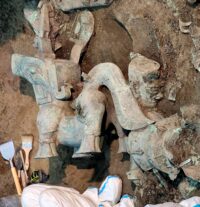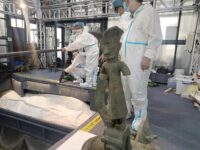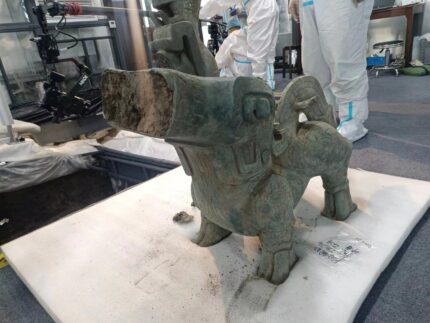 Archaeologists excavating sacrificial pit No. 8 at the Sanxingdui Bronze Age archaeological site in Guanghan City, southwest China, have unearthed the largest bronze beast yet, and the only one of its kind.
Archaeologists excavating sacrificial pit No. 8 at the Sanxingdui Bronze Age archaeological site in Guanghan City, southwest China, have unearthed the largest bronze beast yet, and the only one of its kind.
The beast has a wide open mouth, tall, upright ears, a rounded body on short legs and a thick tail curling up and out from a high rump. On his broad chest is engraved a sacred tree of life, bronze versions of which have also been found inside the pits.
“The tree is engraved directly on it and can be seen as Sanxingdui people’s worship of the sacred tree, or has taken the sacred tree as a kind of divine presence,” said [team archaeologist Zhao Hao].
 It also has unique feature never found before on a bronze mythological animal in the pit: a horn on its head with the figure of a man standing on it. He wears a long robe and has a clenched right fist. Archaeologists believe he may have been the beast’s driver or leader.
It also has unique feature never found before on a bronze mythological animal in the pit: a horn on its head with the figure of a man standing on it. He wears a long robe and has a clenched right fist. Archaeologists believe he may have been the beast’s driver or leader.
More than three feet long and three feet high at its highest point, it is unique among the bronze mythological creatures found in the sacrificial pits for its size. Before this discovery, the largest of the bronze beasts was just 11 inches long.
Not only is it the largest zoomorphic bronze unearthed at Sanxingdui, it is also the most complete. Only one of the figure’s arms and one of the creature’s ears are broken. The six pits at Sanxingdui were filled to the brim with thousands of objects made of bronze, gold, jade and ivory that were ritually broken and burned before burial by the Shu people around 3100 years ago. Of the approximately 13,000 objects recovered from the pits since excavations began in 2020, less than 2,500 of them were found intact.
Excavation of pit 8 is ongoing but is expected to be completed in little over a month.
